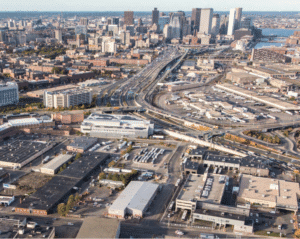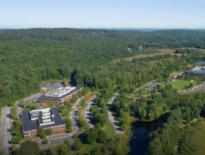
Newmarket property owners say the recent removal of the Mass and Cass encampments comes at a critical time in the neighborhood’s future, as the Boston Planning & Development Agency considers rezoning to attract 21st-century industrial uses. Photo courtesy of the BPDA
The pointed remarks seemingly came out of left field following a technical discussion of proposed rezoning for Boston’s Newmarket industrial district.
“We’ve sort of operated an area there that is very lawless,” a frustrated Rep. Stephen Lynch told Boston Planning & Development Agency directors at a September board meeting. “We don’t enforce the laws down there. There’s open drug use. There’s human trafficking. There’s drug trafficking going on in that area. Does this zoning include applying the laws in that area now? Are we going to change that, or are we just going to turn a blind eye to it?”
The South Boston congressman’s comments, which prompted the board to table approval of a rezoning proposal linked to the agency’s PLAN: Newmarket study, spotlighted the intertwined relationship between Boston’s last purely industrial neighborhood and the nearby epicenter of addiction and homelessness known as “Mass and Cass.”
Investors and tenants in Newmarket say it’s impossible to separate the current prospects and future potential of the neighborhood’s real estate from the stigma gained by its proximity to New England’s most notorious intersection.
The page could be turning to a new chapter in the wake of the city’s removal of the homeless encampments that lined sidewalks at the northern edge of Newmarket in late October.
(sub)New Strategy, New Hope
The Wu administration’s latest strategy to address the homelessness and addiction crisis represents a potential shift in the neighborhood’s perception and, stakeholders hope, could create a future magnet for 21st-century industrial uses ranging from advanced manufacturing to clean energy.
“For the first time in 10 years, our members feel like they can do business without being worried about safety and security every minute,” said Sue Sullivan, executive director of the Newmarket Business Improvement District and the Newmarket Business Association.
The Newmarket Business Improvement District, which began operation in January 2022 with an annual budget of $3 million paid by property owners, has augmented city departments’ response to the Mass and Cass crisis. It provides sidewalk cleanups, security services and employee shuttles from the MBTA Red and Orange lines to member businesses, along with a back-to-work program that matches formerly homeless people with jobs.
“You can’t sell an area that has had the problems we’ve had for the last 10 years,” said Michael Rothschild, president of the Newmarket Business Association and owner of Boston-based developer Abbott Investments. “When people come visit it, those are the challenges they see. By virtue of cleaning it up, the area will become more attractive and potentially attract development as demand drivers reappear.”
In October, the Boston City Council enacted an ordinance giving police the power to remove homeless encampments on public sidewalks near the cluster of drug treatment facilities that have attracted clients from throughout the region. It also requires the city to offer shelter space to displaced homeless people.
A History of Displaced Businesses
At the same time, the BPDA is nearing the conclusion of its PLAN: Newmarket planning process. The 126-page document offers a roadmap to position the neighborhood for emerging 21st-century industries, while preserving the operation of the neighborhoods’ businesses ranging from commercial kitchens and building suppliers to art studios and music rehearsal and recording space.
Designated by Boston officials in the 1950s to relocate food wholesalers from locations such as Quincy Market, Newmarket has remained a relatively low-cost option for both industrial businesses and local artists and musicians.
Both groups have faced displacement pressures in neighborhoods such as Allston-Brighton and South Boston in recent years, as properties are redeveloped by such higher-income-paying uses as life science labs and multifamily housing.
Acknowledging that Newmarket hasn’t remained immune to the same market pressures, the BPDA sought to prevent displacement of current Newmarket businesses when it launched the PLAN: Newmarket study in 2019.
A Backseat to Building Boom
Apart from building contractor F.W. Webb’s new office and distribution center nearing completion on Hampden Street, few major developments have been completed in the past decade in the northern end of the Newmarket.
Local property owners say the neighborhood’s backseat view of Boston’s recent development boom reflects the stigma of Mass and Cass, and the desire of owner-operated properties to remain in a prime location close to downtown, the Massachusetts Turnpike and Interstate 93.
A 2019 survey determined that a slight majority of the properties in Newmarket are owned by the operating businesses, which are reluctant to sell or relocate because of potential disruption to their operations, The Newmarket BID’s Sullivan said.
About 40 multigenerational companies still operate in Newmarket, and commercial vacancies remain in the low single digits, illustrating the continuing demand for industrial space.
“There’s not a lot for lease. I get calls every week, and I can’t find 10,000 square feet,” Sullivan said.

Allston-based City Realty Group proposed an unusual, 220,000-square-foot hybrid industrial-office building at 17 Bradston St. in 2021. Neighborhood stakeholders hope Newmarket could be a future magnet for advanced manufacturing and clean energy. Image courtesy of Embarc
Zoning to Subsidize Industry, Creatives
The challenge for city planners, Rothschild said, is to anticipate what commercial uses will be in growth mode in the coming decades.
“There are a lot of jobs that don’t exist today that will be here in 15 years: green tech, tough tech, clean energy. Anticipating that demand is the biggest challenge: where that stands and when it materializes,” he said.
One element of the rezoning plan creates a new building category in the core subdistrict, allowing higher-rent-paying uses such as labs and offices on upper floors of buildings, while requiring industrial uses on the first two levels.
“All of a sudden, a new building with more density becomes feasible because of that higher-rent-paying tenant upstairs,” said Jeffrey Myers, research director at brokerage Colliers in Boston. “We have a need for industrial [in Boston’s core]. Wherever you have people and businesses and stores and hotels, there is a need for storage and there has to be space in reasonable proximity to that. Boston has identified Newmarket as a location that can supply a good chunk of that.”
The BPDA recently enacted a similar hybrid zoning in South Boston’s Raymond L. Flynn Marine Park, another neighborhood where developers have seen more demand for life science space than industrial buildings in recent years. Cronin Group’s 236,000-square-foot development at 24 Drydock Ave. would include space for Boston Ship Repair along with life science space on upper floors. The project is still finalizing permitting with city and state agencies, according to a statement provided by Cronin Group this week.
A similar approach emerged in Newmarket in 2021, when Allston-based City Realty Group proposed a 220,000-square-foot hybrid building at 17 Bradston St. targeting a mix of industrial uses such as advanced manufacturing and office space. The permitting has been on pause pending the approval of the PLAN: Newmarket rezoning, and developers intend to submit an updated proposal, City Realty Director of Acquisitions Cliff Kensington said.
Local musicians faced with dwindling choices for rehearsal and recording space in Boston still have an option in Newmarket at The Record Co., but Executive Director Matt McArthur says the rezoning is critical to stabilizing the arts and creative economy’s future.
“Any art space that doesn’t have a 20-year position is under threat,” said McArthur, whose studios dodged displacement following the acquisition of its 12-year-old headquarters by National Development in 2021. The studio shares space with medical offices in the 960 Massachusetts Ave. building following a renovation and repositioning project.
“The idea of having a bunch of different uses in one building sounds like a good idea for us: building connections between individuals and business sectors that wouldn’t ordinarily be bumping into each other,” he said.

Steve Adams
Missed Opportunity for ‘Next Bright Star’?
One use that’s not in the proposed mix for Newmarket is housing, part of the BPDA’s “industrial preservation” strategy that acknowledges the likelihood that multifamily developers would be able to pay more for parcels in the neighborhood and crowd out industry.
But one property owner faults the proposed PLAN: Newmarket for shortchanging the neighborhood’s potential for a Seaport District-like transformation.
Zachary Haroutunian’s family, owners of the Taurus Packing wholesale food distribution company on Shirley Street, also owns a cluster of rowhouses just outside of the PLAN: Newmarket study area but within the Newmarket BID.
Haroutunian said the PLAN: Newmarket’s proposal for maximum building heights of eight stories, and a ban on residential development, is a missed opportunity to create a mixed-use neighborhood.
“This area is so centrally located and primed to become the next bright star of development in the city,” Haroutunian said. “I want to see this area succeed and grow and become a bastion of great development. This plan is fundamentally the wrong direction.”





